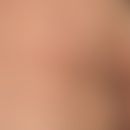Synonym(s)
DefinitionThis section has been translated automatically.
Most common (about 50% of all cutaneous T-cell lymphomas/CTCL), chronic progressive, phased, primary cutaneous T-cell lymphoma (low malignant T-cell lymphoma), which originates from CD4-positive, small to medium-sized T-cells (T-helper lymphocytes/CD4+skin-resident Trm cells).
Functionally, the neoplastic T helper cells are assigned to a TH2 pattern, which is characterized by a corresponding cytokine profile(IL-4, IL-5, IL-10) with possible consecutive eosinophilia and a potential immunoglobulin increase (IgE, IgA).
ClassificationThis section has been translated automatically.
See clinical picture below.
- Special forms and (partly controversial) clinical and histological variants of mycosis fungoides:
- Elastolytic T-cell lymphoma (assessed differently as an entity)
- Folliculotropic mycosis fungoides (synonym: follicular mycosis fungoides; MF with follicular mucinosis; alopecia mucinosa; mucinosis follicularis, see above)
- Syringotropic mycosis fungoides (see folliculotropic mycosis fungoides below)
- Granulomatous mycosis fungoides (see also lymphoma, cutaneous T-cell lymphoma, elastolytic = granulomatous slack skin)
- Pagetoid reticulosis
- Erythrodermic mycosis fungoides (synonym: Sézary syndrome).
- Individual case descriptions:
- Mycosis fungoides with dermal mucin deposits
- Bullous/dyshidrotic mycosis fungoides
- Pustular mycosis fungoides
- Hyper- and hypopigmented (poikilodermic) mycosis fungoides
- Ichthyosiform mycosis fungoides
- Purpura pigmentosa-like mycosis fungoides
- Perioral dermatitis-like mycosis fungoides
- Hyperkeratotic-verrucous mycosis fungoides, partly also under the picture of seborrhoeic keratoses (Sanli H et al. 2025)
- Vegetating/papillomatous mycosis fungoides
You might also be interested in
Occurrence/EpidemiologyThis section has been translated automatically.
Incidence: 3.65-3.92/100,000/inhabitants/year.
EtiopathogenesisThis section has been translated automatically.
As yet unknown. Infectious agents, ultraviolet rays or occupational exposure are being discussed as possible triggers. A familial component is not known. Genomic alterations in putative oncogenes and tumor suppressor genes, including the NF-kappaB and Jak-STAT signaling pathways, are known. Epigenetic modifications as well as dysfunctional regulation of cytokines and other signaling molecules are thought to play a crucial role in malignant transformation.
The proliferating tumor cell of MF has been identified as a "skin-resident effector memory T cell" (see Trm cells below) of clonal origin, which are part of the local immune defense of the skin. They are long-lived and committed to their home tissue. CTCL cells express cytokines of various types. T helper cell subtypes(Th2, Th17 and Treg cells). While immunological homeostasis leads to a constant influx and outflux of lymphocytes into the skin organ, this balance is disturbed in mycosis fungoides. The expansion of clonal CD4+ T lymphocytes leads to "skin-homing" in the uppermost layer of the skin. In some cases, type IV allergic reactions are observed in MF patients. This disturbance of the immune balance also indicates increased activity of T helper cells. The production of chemokines by keratinocytes plays a decisive role here.
According to recent data, the tumor microenvironment of early MF consists mainly of benign Th1 cells, regulatory T cells (Treg) and cytotoxic CD8+ T cells(tumor-infiltrating lymphocytes or Til cells), which initially probably control the malignant cells. The expansion of clonal CD4+ T lymphocytes leads to "skin-homing" in the uppermost layer of the skin. T lymphocytes accumulate around the epidermal Langerhans cells and form abscess-like clusters, which appear under the light microscope as Pautrier's microabscesses (see also Munro's microabscesses in psoriasis).
At the onset of the disease, there is a shift from the benign "bystander infiltrate" with a Th1 phenotype to a predominant Th2 phenotype with consecutively induced eosinophilia and elevated (non-specific) IgE (Brunner PM et al. 2020). A reversal of this shift from Th1 to TH2 was observed independently of the tumor cell burden with different, successful therapies. Previously unknown. Excessive proliferation mostly of T helper cells (see peripheral T-cell lymphomas below). While immunological homeostasis leads to a constant migration of lymphocytes into and out of the skin organ, this balance is disturbed in MF. The Th1 immune signature is considered protective in the early stages of T cell proliferation. The gradual loss of this signature and the predominance of the Th2 immunosignature is attributed to the progression of the disease. Th2 cytokines are thought to suppress the proliferation of benign T cells and prevent the maturation of dendritic cells (DCs). Immature DCs can induce tolerance by presenting antigens to T cells without appropriate co-stimulant, thereby promoting a "tumor-tolerant" microenvironment. Immature DCs are detectable in MF lesions at elevated levels, a potential sign of malignancy.
In some cases, type IV allergic reactions are found in patients, suggesting increased activity of T helper cells. The production of chemokines by keratinocytes plays a decisive role here.
In addition to their "skin-homing" properties, activated T cells can also become secretory active and thus intervene in the inflammatory process in an immunomodulatory manner. Furthermore, neoplastic T cells show a reduction in apoptosis, which delays their degradation.
An increased colonization rate with Staphylococcus aureus also appears to be of pathogenetic significance (see also atopic eczema). Its toxins, which belong to the superantigens, are able to stimulate T-cells in a special way. From this perspective, eradication is recommended (Jonak C et al. 2021).
In the early phase of the disease, T lymphocytes accumulate around the epidermal Langerhans cells and form abscess-like clusters that appear under the light microscope as Pautrier's microabscesses (see also Munro microabscesses in psoriasis). In addition to their "skin-homing" properties, activated T cells can also become secretory active and thus intervene in the inflammatory process in an immunomodulatory manner.
ManifestationThis section has been translated automatically.
Onset in the 5th-7th decade of life (mean age of onset 55-60 years).
Rarely in childhood (age range 20-90 years).
Progression over several years (decades).
Men are affected 1.5-2.0 times more frequently than women.
LocalizationThis section has been translated automatically.
Torso and flexor-sided thighs, flexor-sided upper arms, especially proximal third. In late stages, the entire integument is affected.
ClinicThis section has been translated automatically.
Clinically diverse and variable picture (mean time interval from first symptoms to diagnosis: 4.2 years!). Skin symptoms are initially in the foreground, systemic involvement is only detectable after a longer clinical course. The clinical course of mycosis fungoides is roughly divided into 3 stages, which generally occur one after the other, but can also occur in parallel:
-
Initial stage (pre-mycosis stage) ("patch-stage"):
- Usually few (< 10), rarely solitary, stationary patches occurring in areas not exposed to the sun (chest, flexor side of the upper arms and thighs, other parts of the trunk e.g. flanks). The face is rarely affected in the early stages!
- Sharply defined, large-area (length > 5.0 cm; width > 3.0 cm), aligned in the cleavage lines of the skin, either homogeneous red or red-brown spots/erythema with a crinkled surface (like cigarette paper). A colorful surface pattern (poikilodermatic) with intralesional, alternating brown, brown-red and white patches and telangiectasias is also possible.
- Clinically less characteristic, eczema-like picture, moderate or absent itching. Minor to absent, mostly small-spotted scaling. The skin lesions remain stable in number and size for years. Exposure to sunlight and local glucocorticoid therapy often leads to significant improvement, but not to healing.
-
Plaque stage:
- A suspicious sign of impending progression of the lymphoma is an increasing, stronger "inflammation" of the patches and an accentuated poikilodermatic aspect as well as an increasing increase in consistency.
- Increasing itching.
- Increasing scaling.
- Large-area plaques with significantly increased consistency. The previously "eczema-like" foci, which are more noticeable in untanned skin and can disappear completely in summer, increasingly increase their clinical presence with constant localization. They spread, with a tendency to confluence and an increasing increase in consistency.
- Color: bright red.
- Lymphadenopathy is possible and usually non-specific.
- Infestation of the capillitium may cause alopecia.
- Diagnosis can now be confirmed both clinically and histologically.
- At this stage of the disease, mycosis fungoides is increasingly perceived by the patient as a threatening "disease".
-
Tumor stage:
- Red, mushroom-shaped or lobulated, bulging nodules in plate-like, thickened, arcuately configured, lesional skin; tendency to ulceration.
- Therapeutically hardly controllable itching, severe in affected skin.
- Specific lymph node infestation.
- Infestation of internal organs (liver, spleen) is possible.
- Increasingly marked disturbance of the general condition with febrile episodes.
- Tendency to septic bacterial and viral infections (frequent cause of death).
Concomitant symptoms of mycosis fungoides:
- Mucosal involvement: Possible in any phase; in particular of the oral mucosa, tongue, tonsils, nasal cavities, pharynx.
- Organ involvement: Involvement of the spleen, liver, lungs, gastrointestinal tract or CNS in later stages of the disease. Note: Organ involvement is an indication of a change in the "homing behavior" of the tumor cells.
Variants of mycosis fungoides:
- Pagetoid reticulosis: Misnomer for a localized, low-malignant cutaneous T-cell lymphoma with unusually pronounced epidermotropy. Clinically, a distinction is made between a localized and a disseminated type.
- Folliculotropic mycosis fungoides: Rare variant of mycosis fungoides with follicularly accentuated, grater-like surface texture
- Syringotropic mycosis fungoides: Rare variant with preferential infiltration of the eccrine sweat glands.
- Granulomatous slack skin: Very rare granulomatous variant (< 100 cases in the world literature) of a usually CD4-positive, cutaneous T-cell lymphoma, which is characterized by granulomatous tissue formations and loss of elastic fibres. The prognosis for this variant is worse than for the classic form (5-year survival rate around 60%).
Hypopigmented mycosis fungoides: Rare poikilodermatic variant with a good prognosis, which is mainly observed in children (skin type IV-VI according to Fitzpatrick).
Erythrodermic mycosis fungoides: Erythroderma can occur in the advanced stage of mycosis fungoides. More rarely, it is a primary erythrodermic onset of mycosis fungoides. In this case, differentiation from Sezary syndrome would be difficult.
Unilesional and palmoplantar forms of mycosis fungoides. They are difficult to diagnose both clinically and histologically. They are usually only suspected due to their resistance to therapy and the later appearance of plate-like infiltration of the lesions.
LaboratoryThis section has been translated automatically.
HistologyThis section has been translated automatically.
The discontinuation of local or systemic glucocorticoid therapy is important for a histopathological assessment!
Initial or patch stage: Varyingly dense, band-shaped or lichenoid, subepidermal infiltrate of small, epidermotropic, neoplastic CD4+ lymphocytes, a mixture of non-neoplastic CD4- and CD8+ lymphocytes and dendritic cells. Eosinophilic granulocytes and histiocytes are present in varying densities. Plasma cells are usually absent! Typical: bead-like accumulation of lymphocytes at the dermo-epidermal junction zone(lining-up phenomenon). Moderate epidermotropy of atypical lymphoid and monocytoid cells into the epidermis. The invaded cells often appear enlarged in the epidermis and are surrounded by an optically empty halo (halo cells). A typical spongiosis is absent, as is a pronounced parakeratosis (differentiation from eczema). Pautrier's microabscesses are detectable, but rather rare in this stage.
Plaque stage: Dense, dermal (papillary and reticular dermis) infiltrate of atypical, small but also medium-sized lymphocytic cells. Eosinophilic granulocytes and histiocytes are present in varying densities. Significant epidermotropy with formation of Pautrier's microabscesses (characteristic of this phase). The epidermis is often acanthotic with parakeratotic keratinization. Frequent adnexotropia (follicles and sweat glands) with destruction of the adnexa.
Tumor stage: Dense, diffuse or nodular, dermal or subcutaneous infiltrate of atypical, medium-sized, lymphocytic cells. Eosinophilic granulocytes and histiocytes in varying densities. High mitotic activity (MIB 1). Occasionally also immunoblasts or large anaplastic CD30+ cells. Mostly still clear epidermotropy. Pautrier microabscesses may occur, but are never obligatory. Epidermotropism may be completely absent at this stage of development! The epidermis is acanthotic but also atrophic. Parakeratotic keratinization. The follicles are often destroyed. Epithelial regeneration of the follicles is often detectable in the infiltrate.
In about 25% of cases, the tumor stage transforms into a diffuse large cell lymphoma, which can be either CD30- or CD30+. The prognosis is then significantly worse. The histological picture is then identical to that of primary cutaneous T-cell lymphomas, which occur without precursor stages.
Recent studies show that CD4-CD8-negative lymphocytes can indicate an early form of mycosis fungoides immunohistochemically.
DiagnosisThis section has been translated automatically.
The diagnosis is made clinically. Accurate tumor staging is necessary for disease definition (see table). In addition to routine laboratory and organ analysis, diagnosis confirmation and tumor staging is performed by histologic, immunohistologic, molecular biologic, and imaging radiologic (CT/nuclear spin studies) and sonographic examinations.
- Immunophenotyping: This allows differentiation between T and B cell series; also detection of T cell subpopulations using CD4, CD8 and CD30 antibodies. Antibodies to CD45RO+ memory T lymphocytes are frequently detected in the early form of mycosis fungoides.
- T-cell receptor gene rearrangement: Diagnostically important (although not conclusive); detection of monoclonality of T-cell infiltrates possible by this method.
- FACS analysis: diagnostically important: in cases of v.a. leukemic course (always in Sézary syndrome).
- Lymph node diagnostics: Sonographic examination of lymph nodes close to the skin; if necessary, lymph node biopsy and fine tissue diagnostics.
- Bone marrow biopsy: Since bone marrow involvement is rare in the early forms of CTCL (T1-3, N0-1, M0), this diagnostic procedure can generally be omitted.
Differential diagnosisThis section has been translated automatically.
The clinical differential diagnosis of mycosis fungoides depends on the clinical stage of the disease and its clinical variants (see classification below). In this respect, this chapter will not contain a generally valid differential diagnosis.
Initial stage: Depending on the stage of development and spread of the spots, very different clinical pictures appear. An important indicator sign is the longitudinal alignment of the patches in the cleavage lines (tension lines) of the skin. This macro-pattern is only common to a few diseases(see there).
- Parapsoriasis en plaques: Few (on average up to 6) usually only discretely inflamed, larger (usually over 10 cm in diameter), roundish or oval, sharply defined, slightly scaly patches or plaques. Longitudinal axes usually aligned with the cleavage lines. Frequently precursors of mycosis fungoides. Histologic clarification.
- Microbial eczema: Initially mostly small, reddish-brownish, itchy, red scaly or crusty papules or papulo-vesicles. Gradual growth in size to sharply or blurredly defined, 1.0-6.0 cm large, red coin-like ("nummular eczema") plaques with yellowish crusts or scaly crusts. No lump formation. The clear "eczematous character" speaks against the diagnosis of "mycosis fungoides". Further histological clarification!
- Psoriasis vulgaris: The classic distribution pattern on the extensor side speaks against mycosis fungoides. The typical psoriasis phenomena such as the Auspitz and Köbner phenomena are also always absent.
- Eczema, atopic: Important here is the medical history with the typical type I allergies; in the eczematoid form there are scaly, partly eroded, scratched and crusted plaques of varying red color. There is always marked itching. Histology: typical eczema morphology.
- Pityriasis rosea: Stem-emphasized, intermittent exanthema lasting 1-2 weeks; aligned according to the cleavage lines (Christmas tree pattern), foci: 0.2-1.0 cm large, oval or elongated, slightly raised, scaly plaque. Acuity of the symptoms speaks against mycosis fungoides.
Plaque stage: A plaque stage will always be combined with premycotic (eczema-like) changes in the classic form of the disease. In this respect, this picture is characterized by a variety of manifestations. Histologic and immunohistologic confirmation will always be necessary to clinically confirm the diagnosis.
- Pseudolymphomas of the skin: Rather monomorphic appearance. No history over many years. Histology does not show the typical changes of the mycotic infiltrate.
- Leukemias of the skin: Very different clinical pictures, mostly exanthematic spread. No staged course as in mycosis fungoides. No poikiloderma.
- Lupus erythematosus tumidus: Mostly disseminated, chronically stationary, 0.5-5.0 cm large, red, usually not hypersensitive, sharply defined papules and plaques with a smooth, shiny, non-scaly surface. Pronounced photosensitivity. No staged course as in mycosis fungoides.
- Urticaria pigmentosa: Flat, oval or round, grayish-brown or brown patches of varying size with urticarial reaction (this phenomenon is completely absent in mycosis fungoides). Frequently elevated dermographism.
- Tinea corporis: This differential diagnosis is only considered in untreated extensive forms. Marginal accentuation of the foci, itching, scaling; native and cultural piz detection.
- Sézary syndrome: primary erythrodermic (>80% of the body surface) T-cell lymphoma with lymphadenopathy and evidence of Sézary cells in the peripheral blood.
Tumor stage:
- other cutaneous T-cell lymphomas: In this case the phased course is absent. Mostly primary nodule formation. Histology is conclusive.
- Cutaneous B-cell lymphomas: In this case the phased course is absent. Mostly primary nodule formation. Histology is conclusive.
Complication(s)(associated diseasesThis section has been translated automatically.
Around 20% of patients are diagnosed with a dual malignancy: Hodgkin's lymphoma, myelodysplastic syndrome, leukemias (AML, CML, CLL) (Pokert S et al. 2024)
TherapyThis section has been translated automatically.
The treatment concept for mycosis fungoides is generally classified as palliative. Exceptions are allogeneic stem cell transplantation as a potentially curative therapeutic approach. The choice of therapy is stage-adapted with predominantly skin-directed therapies in early stages of MF (=/<IIA) and systemic therapies as well as combination therapies in advanced stages (=/>IIB).
Radiation therapyThis section has been translated automatically.
Radiological therapy methods are successful (targeted irradiation with fast electrons) for unilesional or few foci and are rightly used.
In the generalized patch or plaque stage (T2-3), whole-body electron irradiations are an important therapeutic option (ED 1.5-2.0Gy; GD <30Gy). In several studies, complete remissions of 75% were achieved in stage T2 and 47% in stage T3.
Progression/forecastThis section has been translated automatically.
"Indolent course". The duration of the pre-mycosis stage can range from 5 years to more than 20 years. Regressions and recurrences are possible.
In early-stage MF, the 5-year OS is 84.0% and the 10-year OS is 63.0% (PorkertS et al. 2024)
Mean survival rate (all stages): 11.4 years
Mean survival rate (stage-dependent):
- T2 patients: 12.1 years
- T3/T4 patients: 3-4 years
- N0 patients: 17.5 years
- N1 patients: 6.5 years
- N2 patients: 1.7 years
- B0 patients: 12.3 years
- B1 patients: 3.0 years.
TablesThis section has been translated automatically.
Staging of mycosis fungoides
Pre-mycosis stage (patch stage) |
Minor pruritus or uncharacteristic red, more rarely urticarial, eczematous patches. Duration of the patch stage: 5 years to > 20 years. Regressions and recurrences are possible. 5-year survival rate: 66.1%, 10-year survival rate: 43.2%. |
Infiltrative stage (plaque stage) |
Squamous infiltrated, sharply defined, bizarrely configured, slightly scaly or crusted, very itchy, red, reddish-purple or brownish-red lesions that slowly increase in size. Sharply defined islands of normal skin in the middle of these areas (nappes claires). In the capillitium area: circumscribed alopecia. Swelling of the lymph nodes. |
Mycoside (tumorous) stage (tumor-stage) |
Tumor development in the area of the infiltrated foci, usually after years or decades of disease. Hemispherical, possibly lobulated, mostly soft, mushroom-shaped, blue to brown-red, eroded, weeping and ulcerated tumors on the surface. Generally rapid progression with lethal exitus. |
T (skin) | |
T1 limited skin infestation with plaques (< 10% KO) | |
T2 generalized plaques (>10% KO) | |
T3 Cutaneous tumors (> 1 cm in diameter) | |
T4 Generalized infestation (> 80% KO) or erythroderma | |
N (lymph nodes) | |
N0 No lymph node enlargement, histologically without involvement | |
N1 Enlarged lymph nodes, histologically without involvement | |
| |
| |
N2 no lymph node enlargement, but histologically affected | |
| |
| |
N3 Lymph node enlargement with histological involvement (Dutch grade 3-4) | |
| |
| |
M (Visceral organs) | |
M0 no organ involvement | |
M1 organ involvement | |
B0 no atypical lymphocytes in the peripheral blood (< 5%) | |
B1 atypical lymphocytes in the peripheral blood (> 5%) | |
B2 High tumor burden in peripheral blood (>1000 /ml Sézary cells with positive clone) | |
M0 No involvement of visceral organs | |
M1 Histologically confirmed involvement of visceral organs | |
Stage I |
Limited (IA) or generalized plaques (IB) (T1 N0 M0 or T2 N0 M0) |
Stage II |
Limited or generalized plaques with lymph node enlargement (IIA) or cutaneous tumors with/without lymph node enlargement (IIB), histologically without lymph node involvement or organ involvement (T1-2 N1 M0 or T3 N0-1 M0) |
Stage III |
Generalized erythroderma with/without lymphadenopathy, no histological involvement of lymph nodes or organs (T4 N0-1 M0) |
Stage IV |
histological involvement of lymph nodes (IVA) or organs (IVB) (T1-4 N2-3 M0 = IVA or T1-4 N0-3 M1 = IVB) |
|
T |
N |
M |
B |
IA |
1 |
0 |
0 |
0,1 |
IB |
2 |
0 |
0 |
0,1 |
II |
1-2 |
1-2 |
0 |
0,1 |
IIB |
3 |
0-2 |
0 |
0,1 |
III |
4 |
0-2 |
0 |
0 |
IIIA |
4 |
0-2 |
0 |
0 |
IIIB |
4 |
0-2 |
0 |
1 |
IVA1 |
1-4 |
0-2 |
0 |
2 |
IVA2 |
1-4 |
3 |
0 |
0-2 |
IVB |
1-4 |
0-3 |
1 |
0-2 |
AftercareThis section has been translated automatically.
Tumour stage Ia and Ib: clinical examination and palpation of the lymph nodes every 6-12 months.
In more advanced stages, closer monitoring with imaging (lymph node sonography, CT thorax/abdomen) and laboratory chemistry (differential blood count, FACS analysis) diagnostics.
Note(s)This section has been translated automatically.
The term mycosis fungoides should be used only for the classic "Alibert-Bazin" type. An early form of mycosis fungoides can be evaluated according to an algorithm elaborated by Pimpinelli et al (> 4 points = mycosis fungoides probable):
- Clinic:
- Persistent or progressive patches or plaques (1 point).
- Localization not sun-exposed/large area, poikilodermic (1 point).
- Histology:
- Superficial lymphoid infiltrate, cellular and nuclear atypia, epidermotropism (1 point)
- Molecular Biology:
- Clonal T-cell pattern (1 point)
- Immunohistology:
- < 50% of T cells express CD2, Cd3 and/or CD5.
- < 10% CD7 (1 point)
- Increased number of lymphocytes (CD2, CD3, CD5, CD7) in the epidermis (disproportionate epidermotropism) (1 point).
Case report(s)This section has been translated automatically.
The efficacy of pegylated liposomal doxorubicin for the treatment of mycosis fungoides has been described in several studies. Controversy continues to surround the efficacy of the therapy. In 2000, Wollina et al. reported a clinical response of 83% in a case report with 6 patients. Subsequent studies have also published similarly good results. However, the significance of these studies is limited by the small number of subjects.
LiteratureThis section has been translated automatically.
- Alibert JLM (1806) Description des maladies de la peau observees a l'Hospital Saint-Louis et exposition des meilleures methodes suivies pour leur traitement. Paris, Barrois l' aine et fils: 157
- Auspitz H (1885) A case of granuloma fungoides (Mycosis fungoides Alibert). Vierteljahresschrift für Dermatologie und Syphilis (Vienna) 12: 123-143
- Breneman DL (2003) Lymph node grading for staging of mycosis fungoides may benefit from examination of multiple excised lymph nodes. J Am Acad Dermatol 48: 702-706
Brumfiel CM et al. (2021) How to Sequence Therapies in Mycosis Fungoides. Curr Treat Options Oncol 22:101.
Brunner PM et al. (2020) Recent advances in understanding and management cutnneous T-cell-lymphomas. F1000 RFEs.9:F10000
- Diederen PV et al. (2003) Narrowband UVB and psoralen-UVA in the treatment of early-stage mycosis fungoides: a retrospective study. J Am Acad Dermatol 48: 215-219
- Duvic M et al. (2006) A phase II open-label study of recombinant human interleukin-12 patients with stage IA, IB, or IIA mycosis fungoides. J Am Acad 55: 807-813
- Eich D et al. (1999) Photodynamic therapy of cutaneous T-cell lymphoma at special sites. Dermatology 50: 109-114
- Glusac EJ (2003) Criterion by criterion, mycosis fungoides. Am J Dermatopathol 25: 264-269
- Hagedorn M et al. (2003) Long term results of total skin electron beam therapy (TSEBT) in the treatment of mycosis fungoides. Dermatologist 54: 256-564
- Hodak E et al. (2006) CD4/CD8 double-negative epidermotropic cutaneous T-cell lymphoma: an immunohistochemical variant of mycosis fungoides. J Am Acad Dermatol 55: 276-284
- Jonak C et al (2021) Mycosis fungoides and Sezary syndrome. JDDG 19: 1307.-1333)
- Kempf W et al (2003) Cutaneous T-cell lymphomas. In: Histopathology of the skin. Kerl H et al. (Eds.) Springer Verlag Berlin, Heidelberg, New York S 872-876
- Kim YH et al. (2003) Long-term outcome of 525 patients with mycosis fungoides and Sezary syndrome: clinical prognostic factors and risk for disease progression. Arch Dermatol 139: 857-866
- Krokowski M et al. (2003) Mycosis fungoides in childhood and adolescence with clonal T-cell receptor gamma gene rearrangement. Two cases. Dermatology 54: 536-540
Nasimi M et al. (2020) Childhood mycosis fungoides: A clinicopathologic study of 30 cases from Iran. Australas J Dermatol 61: e259-e261.
Navi D et al (2011) The Stanford University experience with conventional-dose, total skin electron-beam therapy in the treatment of generalized patch or plaque (T2) and tumor (T3) mycosis fungoides. Arch Dermatol.147:561-567
- Paech V et al. (2002) Remission of a cutaneous mycosis fungoides after topical 5-ALA sensitization and photodynamic therapy in a patient with advanced HIV-infection. Eur J Med Res 7: 477-479
- Papadavid E et al. (2003) The relevance of peripheral blood T-helper 1 and 2 cytokine pattern in the evaluation of patients with mycosis fungoides and Sezary syndrome. Br J Dermatol 148: 709-718
- Pimpinelli N (2005) Defining early mycosis fungoides. J Am Acad Dermatol 53: 1053-1063
- Roenigk HH et al. (1990) Photochemotherapy alone or combined with interferon alfa-2a in the treatment of cutaneous T-cell lymphoma. J Invest Dermatol 95: 1988 -2058.
- Şanlı H et al. (2025) Seborrheic keratosis-like mycosis fungoides: A rare variant with clinical, dermatoscopic, and dermatopathological features. J Dtsch Dermatol Ges 23:108-110.
- Talpur R et al.(2008) Prevalence and treatment of Staphylococcus aureus colonization in patients with mycosis fungoides and Sézary syndrome.Br J Dermatol 159:105-112
- Willemze R et al. (1997) EORTC classification for primary cutaneous lymphomas: a proposal from cutaneous lymphoma study group of the European Organization for Research and Treatment of Cancer. Blood 90: 354-371
- Wollina U et al. (2000) Treatment of relapsing or recalcitrant cutaneous T-cell lymphoma with pegylated liposomal doxorubicin. J Am Acad Dermatol 42: 40-46
- Zackheim HS et al. (1990) Topical carmustine (BCNU) or cutaneous T-cell lymphoma: a 15-year experience in 143 patients. J Am Acad Dermatol 22: 802-810
- Zane C et al. (2001) "High-dose" UVA1 therapy of widespread plaque-type, nodular, and erythrodermic mycosis fungoides. J Am Acad Dermatol 44: 629-633
- Zipprich F et al. (2001) Follicular mycosis fungoides (FMF): a rare disease. Dermatologist 52: 240-243
Incoming links (59)
Aggressive cytotoxic epidermotropic cd8-positive t-cell lymphoma; Alibert, jean louis; Angioimmunoblastic T cell lymphoma; Apoptosis; Bexaroten; CCR4 inhibitors; CCR4 receptor protein; Cd30; Chlormethin-Gel; Copblam scheme; ... Show allOutgoing links (43)
Atopic dermatitis (overview); CD4; Cd8; CD classification; Chemokines; Cutaneous t-cell lymphomas; Doxorubicin, liposomal; Eczema (overview); Epidermotropy; Epigenetics; ... Show allDisclaimer
Please ask your physician for a reliable diagnosis. This website is only meant as a reference.



































































